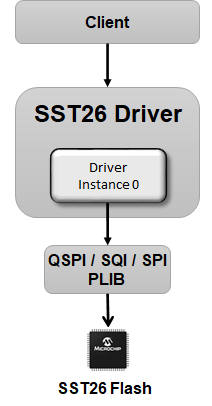1.1.13.2.1 How the Library Works
The sst26 driver library is a single-client, single-instance based driver interface.
Abstraction Model
The SST26 driver interface provides read, write and Erase functions that abstract out the internal workings of the SST26 driver and the underlying QSPI/SQI/SPI protocol.
The client can be:
Application - Directly access the SST26 Flash using the APIs provided by the SST26 Driver library
Memory Driver - Application can run a file system on the SST26 Flash by connecting it to the Memory Driver which can further be connected to the File System Service

Working flow
The SST26 Driver performs initialization and puts the driver to ready state. This status of the driver can be checked using DRV_SST26_Status()
The SST26 driver library performs set of flash operations during DRV_SST26_Open(). If any of the below flash operations fails, an invalid Handle will be returned. DRV_SST26_Open() can be repeatedly called until it returns a valid handle.
- Resets the Flash
- Configures the flash device to QUAD IO Mode if underlying peripheral library is running in QSPI/SQI mode
- Unlocks the flash if it has been opened in write mode
When the client requests for device geometry, it queries for the JEDEC-Id and populates the geometry table DRV_SST26_GEOMETRY appropriately.
The driver does not support queuing of more than one requests. The application must check and ensure that any previous request is completed before submitting a new one. This can be done by polling the status of data transfer using DRV_SST26_TransferStatusGet()
